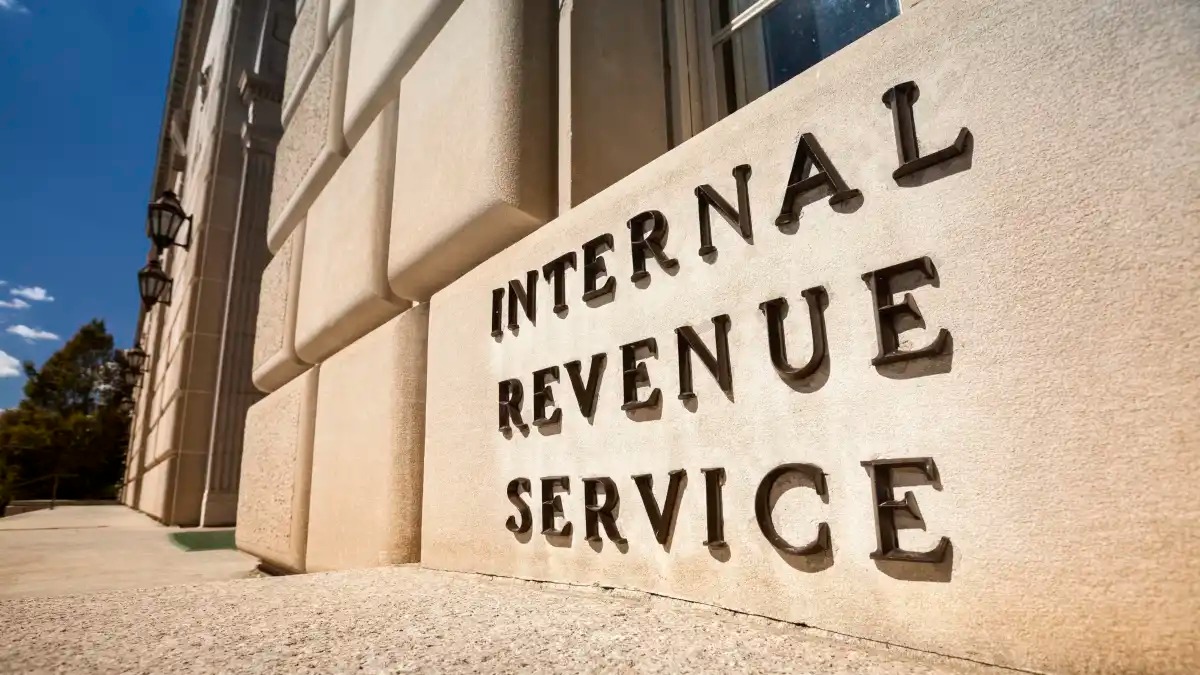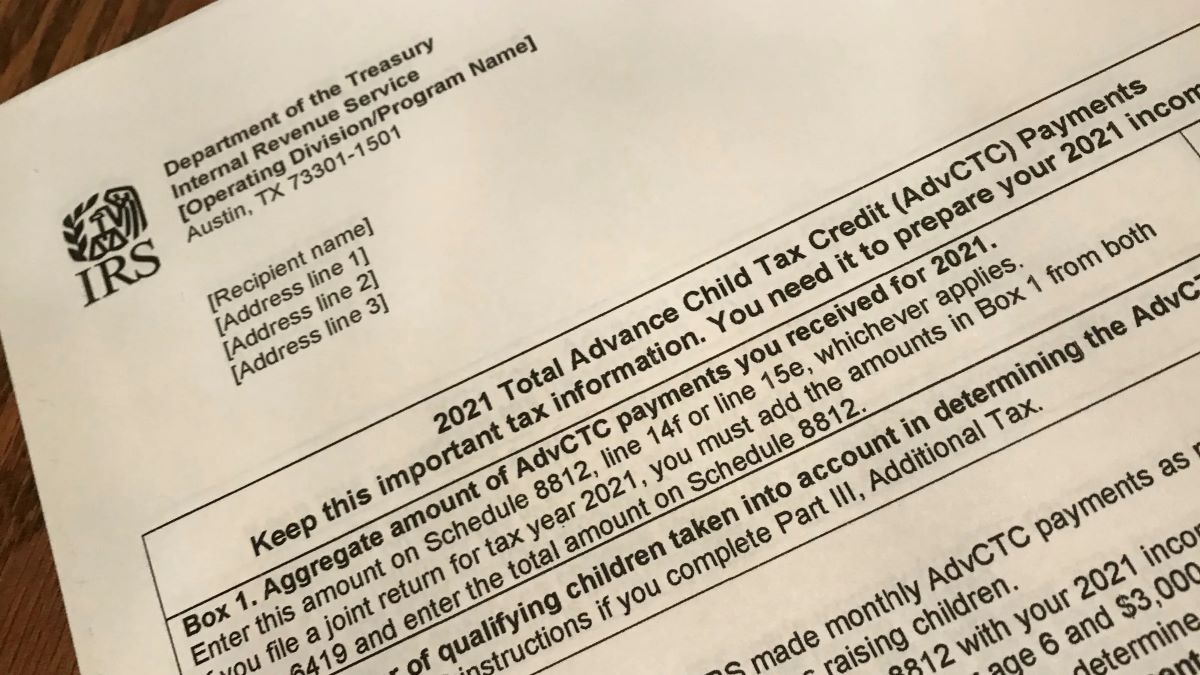

Finance
What Does The IRS Letter Look Like?
Published: October 31, 2023
Curious about what the IRS letter looks like? Get all the information you need about IRS letters and their appearance. Explore now!
(Many of the links in this article redirect to a specific reviewed product. Your purchase of these products through affiliate links helps to generate commission for LiveWell, at no extra cost. Learn more)
Table of Contents
- Introduction
- Purpose of the IRS Letter
- General Appearance of the IRS Letter
- Header Information
- Notice Number
- Important Dates
- Contact Information
- Body of the Letter
- Explanation of the Issue
- Response Required
- Supporting Documentation
- Payment Instructions
- Penalties and Interest
- Appeals Process
- Additional Resources
- Conclusion
Introduction
Welcome to our comprehensive guide on what an IRS letter looks like. If you’ve recently received a letter from the Internal Revenue Service (IRS), you might be wondering what it entails and what actions you need to take. Understanding the contents and appearance of an IRS letter is crucial to effectively responding and resolving any issues with the IRS in a timely manner.
Dealing with the IRS can be intimidating, but knowledge is power. By familiarizing yourself with the general structure and purpose of an IRS letter, you can alleviate some of the anxiety associated with correspondence from the tax authorities. In this article, we’ll walk you through the various elements of an IRS letter, decoding its format so you can decipher its meaning and take the necessary steps to address it effectively.
IRS letters serve a variety of purposes, including informing you of tax issues, requesting additional information or payments, or providing updates on previous inquiries or audits. Each letter is unique, tailored to specific situations and taxpayers. However, there are common elements that you can expect to find in most IRS letters.
Throughout this guide, we’ll provide you with a comprehensive overview of an IRS letter’s appearance and its different sections. We’ll explain what each section means, why it’s important, and how you should respond. By the end, you’ll have a clear understanding of what to expect when you receive correspondence from the IRS and how to navigate through it successfully.
Purpose of the IRS Letter
When you receive a letter from the IRS, it’s crucial to understand its purpose. Each letter is generated for a specific reason, and it’s important to determine the urgency and actions required on your part. Here are some common purposes behind IRS letters:
- Tax Assessment: The IRS may send you a letter to inform you that they have conducted an examination and made changes to your tax return. This assessment could result in additional taxes owed, a refund, or adjustments to your reported income or deductions.
- Outstanding Payments: If you have unpaid taxes, penalties, or interest, the IRS will send you a letter regarding the amount due. The letter will provide details on how much is owed, the due date, and payment options.
- Information Verification: The IRS may request additional information or documentation to verify items reported on your tax return. This could include supporting documents for deductions, income sources, or other financial transactions.
- Audit Notification: If your tax return is selected for an audit, the IRS will send you a letter to inform you of what items they will examine and how to proceed. This letter will outline the documentation and records you need to provide.
- Notice of Intent to Levy: If you have outstanding tax debt and have not responded to previous notices, the IRS may send a letter notifying you of their intent to levy your assets or wages to satisfy the debt.
Understanding the purpose of the IRS letter will help you determine the appropriate actions to take. It’s crucial to read the letter carefully and follow any instructions provided. Ignoring or delaying a response can lead to further complications and potential financial consequences.
Keep in mind that not all IRS letters require immediate action or indicate a negative outcome. Some letters may be informational, providing updates or reminders regarding tax obligations or changes in tax laws. Regardless of the purpose, it’s essential to respond promptly, seeking professional advice if necessary, to address any issues raised by the IRS.
General Appearance of the IRS Letter
IRS letters are typically sent through regular mail and are identifiable by their official format. Here’s a breakdown of the general appearance:
- Envelope: The letter usually arrives in a plain white envelope with the official IRS logo and return address.
- Header Information: Upon opening the envelope, you’ll find the letterhead at the top of the document. This section includes the official IRS logo, the recipient’s name and address, and the date of the letter.
- Notice Number: Below the header information, the IRS letter will include a notice or identification number. This unique number helps both the IRS and the recipient track and reference the specific letter in question.
- Important Dates: The letter will state important dates, such as the date the letter was issued, the response due date, and any applicable deadlines. Pay attention to these dates as they indicate the timeframe within which you need to take action.
- Contact Information: The IRS letter will provide contact information, including a phone number and/or address, to reach out to a specific IRS department or representative handling your case. It’s essential to use the provided contact details for any inquiries or correspondence related to the letter.
As you delve into the body of the letter, you’ll encounter sections specifically addressing the issue at hand. These sections will provide detailed information about the problem, necessary actions, and additional instructions. Be sure to carefully read and understand the content to respond appropriately.
The IRS letter will also include information on how to appeal or dispute the issue if you believe there has been an error, as well as available resources for guidance or further assistance. It’s important to familiarize yourself with these resources to navigate the process effectively.
While the general appearance of the IRS letter may seem formal and intimidating, it’s crucial to approach it with a calm and focused mindset. Take the time to read through the letter carefully, seeking professional help if needed, to ensure you understand the issue at hand and can take the necessary steps to resolve it in a timely manner.
Header Information
The header of an IRS letter contains important information that helps identify the letter and its intended recipient. Here’s what you can expect to find in the header section:
- Official IRS Logo: The header typically features the official logo of the Internal Revenue Service, which consists of the words “Department of the Treasury” and “Internal Revenue Service” along with the unique IRS emblem. This logo helps to establish the authenticity and authority of the letter.
- Recipient’s Name and Address: Directly beneath the IRS logo, you will find the name and address of the individual or entity to whom the letter is addressed. The address listed should match the one associated with your tax records, so make sure to verify its accuracy.
- Date of the Letter: In the header section, you will also find the date on which the letter was issued. This date is important for reference purposes and may be necessary when communicating with the IRS regarding the content of the letter.
The header serves as a quick reference point to confirm that the letter is indeed from the IRS and intended for you. It is advisable to review the header information carefully to ensure it matches your personal details and to confirm the legitimacy of the letter.
If you notice any discrepancies or have doubts about the authenticity of the letter, it is essential to exercise caution. The IRS generally communicates through official channels and does not initiate contact via email or phone without prior notice. If you suspect a letter is fraudulent, it is recommended to contact the IRS directly using the official phone number or address provided on the IRS website.
By paying close attention to the header section of an IRS letter, you can verify its legitimacy and ensure that you are addressing the correct correspondence. This information serves as a starting point for understanding the purpose and importance of the letter, enabling you to take the necessary steps to respond and resolve any issues in a timely manner.
Notice Number
One crucial element of an IRS letter is the notice or identification number. This unique number is assigned to each letter and serves as a reference for both the IRS and the recipient. Here’s what you need to know about the notice number:
The notice number is typically located below the header information and can be found in the top or upper-middle section of the letter. It is a combination of letters and numbers that uniquely identifies the specific communication from the IRS. This number is essential when corresponding with the IRS or seeking assistance regarding the letter.
The notice number helps the IRS track and categorize correspondence, ensuring efficient management of taxpayer inquiries and issues. When discussing your letter with IRS representatives, providing the notice number can help them quickly locate and retrieve the relevant information related to your case.
Additionally, the notice number is crucial for your own records and reference. Keeping track of the notice number allows you to easily access and retrieve the specific letter if needed in the future. If you need to respond to the letter or seek clarification, referring to the notice number can help speed up the process and ensure accurate communication.
When communicating with the IRS regarding the letter, make sure to include the notice number in any correspondence or communication. This helps ensure that your inquiries or responses are directed to the appropriate IRS department and properly linked to your specific case.
Remember, the notice number is unique to each letter and should not be confused with other identification numbers, such as your taxpayer identification number (e.g., Social Security number or Employer Identification Number). Keeping track of the notice number will facilitate effective communication and resolution of any issues raised in the IRS letter.
Important Dates
When you receive an IRS letter, pay close attention to the important dates mentioned within the document. These dates provide crucial information about the timeframe you have to take specific actions. Here are the main types of dates you might find in an IRS letter:
- Date the Letter was Issued: This is the date when the IRS generated and mailed the letter to you. It helps establish the timeline of events and signifies when the IRS initiated contact.
- Response Due Date: The response due date is the deadline by which you must provide a response to the IRS. This date is typically stated prominently in the letter and indicates the maximum time you have to address the issue raised or to provide the requested information.
- Payment Due Date: If the IRS letter involves an outstanding tax liability, penalties, or interest, it will specify a payment due date. This date represents the deadline by which the amount owed should be paid in full to avoid further penalties or collection actions.
- Deadline for Filing an Appeal: In some cases, the IRS letter may inform you of your right to appeal a decision or assessment. If you wish to contest the IRS’s findings, it will specify the deadline by which you must file an appeal. It is crucial to adhere to this deadline if you intend to exercise your right to appeal.
It is essential to carefully note and mark these important dates as you review the IRS letter. Failing to comply with the specified deadlines can have serious consequences, such as increased penalties, additional interest, or missed opportunities for resolution.
If you require additional time to respond to the IRS letter or cannot meet the specified deadlines, it is advisable to contact the IRS as soon as possible. Depending on the circumstances, the IRS may grant extensions in certain situations.
To avoid any issues or misunderstandings related to dates, it is crucial to review the IRS letter promptly upon receipt. Take note of the important dates, set reminders, and ensure you allocate enough time to gather the necessary information, seek professional advice if needed, and submit a timely response.
By paying attention to the important dates stated in the IRS letter, you can effectively manage your responsibilities and ensure a smooth resolution of any tax-related matters.
Contact Information
When you receive an IRS letter, it is vital to take note of the contact information provided. This information allows you to reach out to the appropriate IRS department or representative regarding the content of the letter. Here is what you can expect to find in terms of contact information:
- Phone Number: The IRS letter will typically include a phone number that you can call for inquiries or assistance. This phone number is specific to the department or personnel handling your case and is essential for addressing any concerns or questions you may have.
- Address: In some cases, the IRS letter may provide an address to which you can send documentation or additional correspondence related to the matter at hand. Make sure to use the provided address when submitting any requested information or when correspondingly directly with the IRS through mail.
- Business Hours: The IRS may indicate the specific business hours during which you can contact them via phone or in-person, if applicable. This information ensures that you contact the IRS during their operating hours to receive timely assistance.
It is crucial to use the contact information provided in the IRS letter when seeking clarifications or addressing any issues. Avoid using generic phone numbers or email addresses found online, as they may not connect you with the relevant department handling your case.
When contacting the IRS, be prepared to provide the notice number and any other identification details specified in the letter. This will help the IRS representative locate your file and provide accurate assistance.
Keep in mind that the IRS receives a high volume of calls, and wait times can be long. To save time, consider gathering all relevant documents, preparing a list of questions or concerns, and organizing your thoughts before making the call.
If you prefer written communication, follow the instructions in the IRS letter to ensure your correspondence reaches the appropriate department in a timely manner. Use certified mail or a secure delivery method to document the receipt and delivery of important documents.
By utilizing the provided contact information, you can communicate effectively with the IRS and ensure that your questions are answered, concerns addressed, and any required documentation properly submitted.
Body of the Letter
The body of an IRS letter contains the main content and information regarding the specific issue at hand. This section dives into the details of the matter and provides instructions on how to proceed. Here are the key elements you can expect to find in the body of the letter:
- Explanation of the Issue: The IRS letter will provide a clear and concise explanation of the issue they are addressing. This may include details of any discrepancies, errors, or concerns they have identified in your tax return or financial information.
- Response Required: The letter will specify the required action or response from you as the recipient. This may include providing additional documentation, clarifying certain information, or making payment for outstanding tax liabilities.
- Supporting Documentation: If the IRS requests additional documentation or evidence to support your reported income, deductions, or other financial transactions, they will specify the exact documents they require. It is important to gather and provide the requested documents within the timeframe specified in the letter.
- Payment Instructions: If the IRS letter involves outstanding tax liabilities or penalties, it will provide instructions on how to make the payment. This may include information on available payment methods, such as online payment portals, checks, or electronic fund transfers.
- Penalties and Interest: In case of unpaid taxes or late filings, the IRS letter may outline the penalties and interest that have accrued. It is essential to carefully review this information to understand the financial implications of non-compliance and to take appropriate action.
- Appeals Process: If you disagree with the IRS’s findings or assessment, the letter may include information on how to initiate an appeals process. This section will provide instructions on the steps to follow and the timeframe within which you must file an appeal.
Read the body of the letter carefully to understand the specific issue being addressed and the actions you need to take. Take note of any deadlines mentioned, and if you need clarification or have questions, utilize the contact information provided to communicate directly with the IRS.
If you are uncertain about how to proceed or feel overwhelmed by the information in the letter, consulting with a tax professional or seeking guidance from the IRS can provide clarity and ensure that you take the appropriate steps to resolve the matter.
Remember, addressing the body of the IRS letter promptly and accurately is crucial to resolving any tax-related issues and maintaining a positive relationship with the IRS.
Explanation of the Issue
One of the critical components of an IRS letter is the explanation of the issue being addressed. This section provides a detailed explanation of why the IRS has contacted you and what specific concerns or discrepancies they have identified. Here’s what you can expect to find in the explanation of the issue:
The IRS letter will typically start by stating the purpose of the communication and provide a brief overview of the issue at hand. It may specify whether the letter contains an examination result, a notice of deficiency, a request for information, or another type of communication that requires your attention.
Within the explanation section, the IRS will outline the specific concern or discrepancy that they have identified. This may include errors in reporting income, deductions, or credits on your tax return, discrepancies between reported income on your return and information obtained from third parties (such as employers or financial institutions), or any other issues that require clarification or resolution.
It is essential to carefully read through the explanation provided in the letter to ensure a clear understanding of the issue. If you feel overwhelmed or do not fully comprehend the details, consider seeking assistance from a tax professional who can help interpret and guide you through the information.
If the IRS letter indicates that changes have been made to your tax return or proposed adjustments to your tax liability, it should provide a breakdown of those changes. This allows you to understand the specific areas the IRS has focused on and the impact it has on your tax situation.
Keep in mind that the IRS letter aims to provide you with a clear explanation of the identified issue. If you have questions or require additional information to understand the matter fully, it is advisable to reach out to the IRS using the contact information provided in the letter.
Understanding the explanation of the issue is crucial as it forms the basis for your response and any necessary actions you need to take. By comprehending the problem at hand, you can effectively address the concerns and work towards resolving the matter with the IRS.
Response Required
When you receive an IRS letter, it is essential to carefully review the section that specifies the required response. This section outlines the specific actions you need to take to address the issue at hand. Here’s what you can expect to find in the response required section:
The IRS letter will clearly state what they expect from you in response to the identified issue. It may involve providing additional information, clarifying certain details, or taking specific steps to resolve the matter.
For example, if the IRS is requesting documentation to support items reported on your tax return, the letter will specify which documents are required and the deadline for submission. It is essential to gather the requested documentation and submit it within the given timeframe to ensure compliance with the IRS’s request.
In some cases, the IRS may require you to amend your tax return to correct any errors or omissions. The letter will provide instructions on how to amend your return and may include any necessary forms or schedules that need to be filled out and submitted.
If the IRS is addressing outstanding tax liabilities or penalties, the response required section will provide instructions on how to make payment. This may include information on acceptable payment methods, such as online portals, checks, or electronic fund transfers.
It’s crucial to adhere to the specified response deadline stated in the letter. Failure to respond within the given timeframe can lead to further penalties, interest, or collection actions by the IRS.
If you require more time to gather the necessary information or are unable to meet the response deadline, you can contact the IRS using the provided contact information. In certain circumstances, the IRS may grant extensions or provide guidance on alternative solutions. However, it’s important to communicate with the IRS and seek their approval rather than ignoring or delaying the response.
Understanding the specific response required enables you to take prompt and appropriate action. Be sure to follow the instructions provided in the letter carefully, seek professional assistance if needed, and ensure that you provide all necessary information or take the required steps to address the IRS’s concerns.
Supporting Documentation
In an IRS letter, you may be asked to provide supporting documentation to corroborate the information reported on your tax return or to address specific concerns raised by the IRS. This section outlines what you can expect regarding supporting documentation:
The IRS letter will specify the type of documentation they require and the purpose for which it is needed. This may include documents such as W-2 forms, 1099 statements, receipts, invoices, bank statements, or any other relevant records that support the income, deductions, or credits claimed on your tax return.
It is crucial to gather the requested documents in a timely manner and ensure they are accurate and complete. If you are unable to provide the exact documents requested, consult the IRS letter for any alternatives or contact the IRS directly for further guidance.
When submitting the supporting documentation, it is advisable to make copies for your records and send the original documents to the IRS using a secure delivery method. Remember to include a cover letter referencing the notice number and clearly explaining the contents of the envelope.
If you have difficulty obtaining the requested documentation, contact the IRS using the provided contact information to discuss your situation and explore potential solutions. The IRS may be able to provide alternatives or guidance on how to proceed.
It’s important to note that the IRS may thoroughly review the provided supporting documentation to verify the accuracy of your reported information. Therefore, ensure that the documents are organized and clearly support the deductions, credits, or income claimed on your tax return.
Retain copies of all submitted documentation and correspondence related to the IRS letter. This will help you in case of any future inquiries or if you need to reference the information provided.
By promptly and accurately providing the requested supporting documentation, you demonstrate your cooperation with the IRS and increase the likelihood of a successful resolution to the issues raised in the letter.
Payment Instructions
If the IRS letter involves outstanding tax liabilities, penalties, or interest, it will provide instructions on how to make payment. This section outlines what you can expect regarding payment instructions:
The IRS letter will specify the amount owed, including any taxes, penalties, or interest that have accrued. It will provide guidance on how to calculate the total amount due and explain the breakdown of the charges.
Depending on the specific circumstances and the amount owed, there are different methods you can use to make your payment. The letter will outline the accepted payment methods, which may include:
- Electronic Payment: The IRS provides online payment options, allowing you to make electronic payments directly from your bank account. The letter will provide instructions on how to access the online payment portal and complete the transaction.
- Check or Money Order: If you prefer to make payment by check or money order, the IRS will provide details on how to make the payment. This will include the address to which the payment should be sent and any necessary information to include with the payment, such as your name, taxpayer identification number, or reference number.
- Credit/Debit Card: In certain cases, the IRS may allow payment by credit or debit card. If this option is available, the letter will provide instructions on how to make the payment using this method.
- Installment Agreement: If you are unable to pay the full amount owed upfront, the IRS may offer the option of setting up an installment agreement. The letter will provide guidelines on how to request an installment plan and the necessary steps to follow.
It is essential to carefully review the payment instructions provided in the IRS letter. Adhering to the specified payment methods and deadlines is crucial to avoid further penalties or collection actions by the IRS.
If you are unable to make the payment in full or have concerns about your financial capability to do so, it is advisable to contact the IRS using the provided contact information. They may be able to assist you with alternative payment arrangements or provide guidance on resolving your tax liabilities.
Keep detailed records of your payment, including receipts or confirmation numbers, as documentation of your compliance with the IRS’s payment instructions.
By following the payment instructions outlined in the IRS letter, you can ensure a smooth and prompt resolution of any outstanding tax liabilities or penalties.
Penalties and Interest
When addressing tax issues, it is important to understand the potential penalties and interest that may be associated with unpaid taxes or late filings. The IRS letter will provide information about any penalties and interest that have been assessed. Here’s what you need to know:
Penalties: The IRS imposes penalties for various reasons, such as failure to pay taxes on time, failure to file a tax return, or accuracy-related issues. The exact penalties will depend on the specific circumstances outlined in the letter and can vary in severity. Common penalties include:
- Failure-to-Pay Penalty: This penalty is incurred if you do not pay your taxes by the due date. The penalty amount is a percentage of the unpaid taxes and increases over time.
- Failure-to-File Penalty: If you do not file your tax return by the due date, a failure-to-file penalty may be imposed. This penalty is also a percentage of your unpaid taxes and accrues each month your return is late.
- Accuracy-Related Penalties: If the IRS determines that there are errors or inaccuracies in your tax return, they may impose accuracy-related penalties. These penalties are typically a percentage of the additional tax owed due to the errors.
Interest: In addition to penalties, the IRS also charges interest on the unpaid tax balance. The interest rate is determined quarterly and compounds daily. It is important to note that interest accrues on both the tax amount owed and any associated penalties.
The IRS letter will outline the specific penalties and interest that have been assessed. It is crucial to carefully review this section to understand the financial implications of the non-compliance and the importance of resolving the issue promptly.
If you believe that the penalties or interest have been wrongly assessed or would like to explore options to reduce or eliminate them, the IRS letter may provide information on how to request penalty abatement or interest relief. Follow the instructions provided or contact the IRS using the included contact information to inquire about potential options.
Addressing penalties and interest promptly is essential to minimize financial burdens and maintain a positive relationship with the IRS. By carefully reviewing the penalties and interest outlined in the IRS letter, you can take appropriate actions to resolve the issue efficiently.
Appeals Process
If you disagree with the findings or assessment described in the IRS letter, you have the right to appeal their decision. The appeals process allows you to present your case and potentially reach a resolution without going to court. Here’s what you need to know about the appeals process:
The IRS letter will provide information on how to initiate an appeal. It will specify the deadline by which you must file your appeal and outline the steps you need to follow. It is essential to adhere to the specified deadline to preserve your right to appeal.
The letter will generally instruct you to complete and submit Form 12203, Request for Appeals Review, along with any supporting documentation that supports your position. This form provides a formal structure for presenting your case to the IRS Appeals Office.
When preparing your appeal, it is important to clearly articulate the basis for your disagreement with the IRS’s findings. Provide a detailed explanation of why you believe the assessment is incorrect and how you propose it should be resolved.
Once your appeal is submitted, it will be assigned to an appeals officer who will review your case. The appeals officer is an independent party within the IRS whose role is to impartially consider both your arguments and the IRS’s position.
During the appeals process, you may have the opportunity to discuss your case with the appeals officer. This can be done either in person, by phone, or through written correspondence, depending on the complexity of the issue and the availability of resources. It is important to provide any additional documentation or supporting evidence requested by the appeals officer promptly.
The appeals process provides an opportunity to present your case in a less formal setting and potentially reach a resolution that satisfies both parties. If a resolution is reached, it will generally be in the form of a written agreement or a decision document detailing the outcome.
If you are not satisfied with the outcome of the appeal, you may have the option to further pursue your case in tax court. The letter may provide information on the next steps to take if you choose to go to court.
It is important to carefully review the instructions provided by the IRS in the letter and follow the appeals process accordingly. If you have questions or need guidance throughout the process, consider consulting with a tax professional experienced in dealing with IRS appeals.
By engaging in the appeals process, you can present your case and potentially achieve a resolution that aligns with your position, without the need for litigation.
Additional Resources
When dealing with an IRS letter, it’s essential to be aware of the additional resources available to you. These resources can provide valuable guidance, assistance, and further information to help you address the matter at hand. Here are some common additional resources that may be referenced in the IRS letter:
- IRS Website: The IRS website (www.irs.gov) is a comprehensive online resource where you can find a wide range of information and tools related to taxes. It offers publications, forms, instructions, and various online services to help taxpayers navigate their tax obligations and understand specific tax topics.
- Publication Reference: The IRS letter may refer to specific publications relevant to the issue at hand. Publications provide in-depth explanations and guidance on various tax-related topics. They can help clarify complex tax rules, deductions, credits, and reporting requirements.
- Taxpayer Advocate Service: The Taxpayer Advocate Service (TAS) is an independent organization within the IRS that provides free assistance to taxpayers who are experiencing financial difficulties, significant compliance issues, or disputes with the IRS. The letter may provide contact information for the TAS if you believe your situation warrants their involvement.
- IRS Helpline: The IRS operates various helpline numbers that you can call for general inquiries or assistance. The letter may provide a specific helpline number related to your issue or direct you to the appropriate resources for further assistance.
- Local IRS Office: Depending on the complexity of your case, the letter may suggest contacting your local IRS office for face-to-face assistance. Local offices can provide specific guidance and may arrange appointments to discuss your situation with an IRS representative.
It’s important to leverage these additional resources to gain a better understanding of your tax situation and potential options for resolution. Take the time to explore the IRS website, review relevant publications, and reach out to the appropriate contact points provided in the letter for further assistance.
Additionally, consulting with a qualified tax professional can provide invaluable support and guidance throughout the process. Tax professionals have expertise in navigating IRS matters and can help you understand your rights, obligations, and potential strategies for resolving the issue effectively.
Remember, the IRS provides these resources to assist taxpayers in meeting their tax obligations and addressing any concerns or questions that may arise. Utilizing them can help you navigate the complexities of your tax situation and ensure a positive outcome.
Conclusion
Receiving an IRS letter can be a daunting experience, but understanding its contents and taking appropriate actions is crucial to effectively resolve any tax issues. By familiarizing yourself with the general appearance of an IRS letter, the purpose behind it, and the various sections it contains, you can navigate through the process with confidence.
Remember that IRS letters serve different purposes, such as tax assessments, requests for information, notifications of outstanding payments, or audit notifications. Each letter is unique and tailored to your specific situation.
Within the letter, pay close attention to the header information, notice number, important dates, and contact information. These details serve as important references and help ensure that you are addressing the correct correspondence.
Review the body of the letter carefully to understand the specific issue being addressed and the response required. Whether it involves providing supporting documentation, making a payment, or initiating an appeal, take prompt and accurate action to address the IRS’s concerns.
Penalties and interest may be associated with unpaid taxes or late filings, so be aware of the potential financial implications. If you disagree with the assessment, the letter will provide information on how to initiate an appeal, allowing you to present your case to the IRS Appeals Office.
Additional resources, such as the IRS website, publications, the Taxpayer Advocate Service, helpline numbers, and local IRS offices, are available to assist you throughout the process. Make use of these resources to gain a better understanding of your tax situation and obtain guidance.
In conclusion, when dealing with an IRS letter, it is important to read it carefully, understand its contents, and take prompt and appropriate action. Seek professional assistance if needed, maintain open communication with the IRS, and utilize the available resources to ensure a smooth resolution of any tax-related matters.
Remember, by staying proactive and engaged, you can navigate through the IRS correspondence process effectively and reach a satisfactory resolution while maintaining a positive relationship with the tax authorities.














